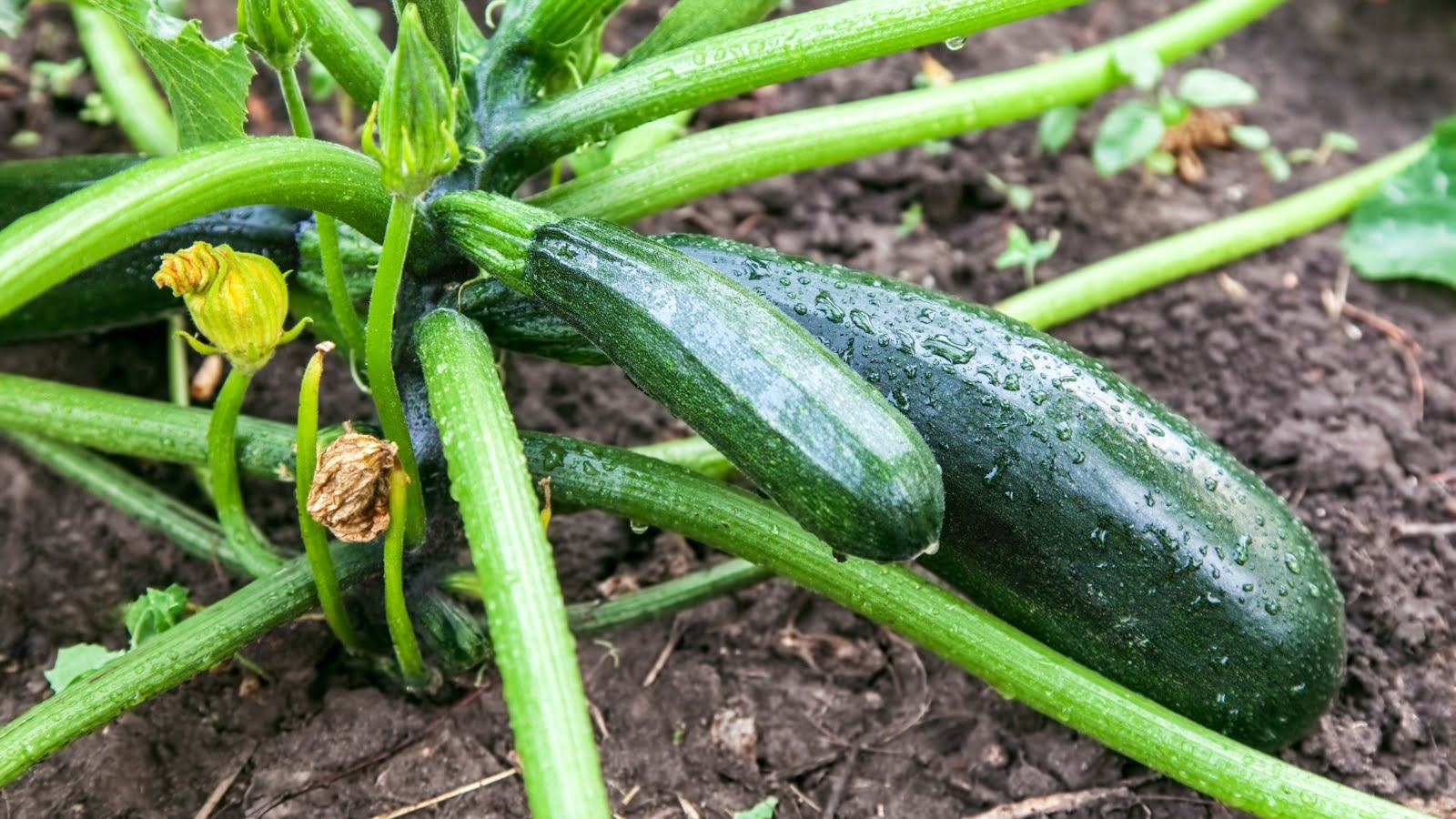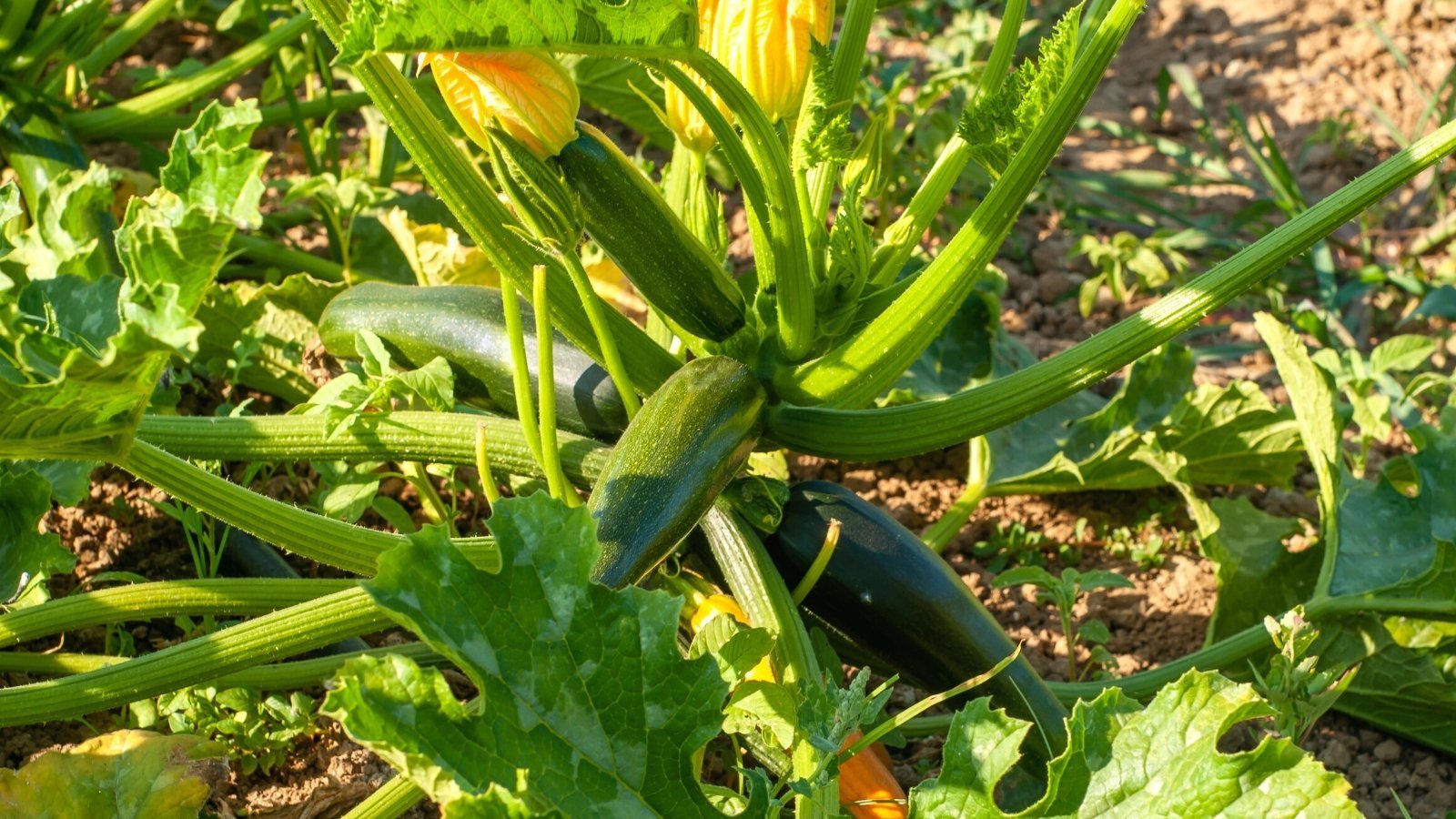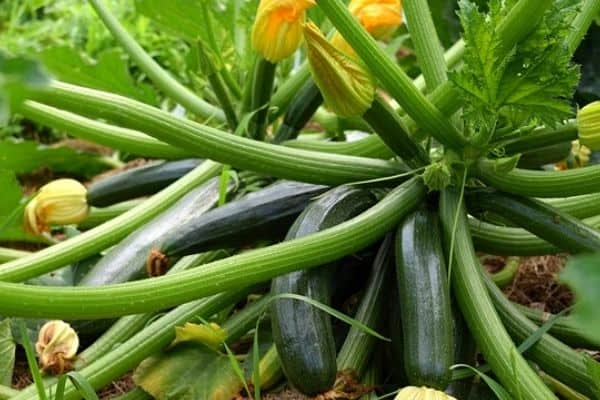Zucchini, a versatile and widely loved summer squash, has a relatively short growing time that can be a pleasant surprise for gardeners. From seed to harvest, it typically takes around 40 to 60 days for zucchini to reach its full potential. This means that with just a little bit of patience and care, you can enjoy the bountiful harvest of these delicious green vegetables in no time. So, whether you are a seasoned gardener or a beginner, get ready to embrace the joy of watching zucchini thrive in your own backyard.

The Growing Time of Zucchini
Zucchini, a popular summer squash, is a versatile and nutritious vegetable that can be easily grown in your own backyard. Whether you’re a seasoned gardener or a beginner, understanding the growth process of zucchini is essential for a successful harvest. In this comprehensive article, we will explore the various stages of zucchini growth, factors that affect its growth rate, how to plant zucchini seeds, and offer tips for promoting optimal zucchini growth.
Understanding Zucchini Growth
Introduction to Zucchini
Zucchini, scientifically known as Cucurbita pepo, belongs to the cucurbit family along with pumpkins and cucumbers. It is a warm-season vegetable that thrives in full sunlight and fertile, well-draining soil. Zucchini plants produce an abundant yield of elongated, green or yellow fruits with a mild and delicate flavor.
Basic Anatomy of a Zucchini Plant
To better understand the growth of zucchini, let’s take a closer look at its basic anatomy. A zucchini plant consists of a root system, stems, leaves, and flowers. The roots anchor the plant in the soil and absorb water and nutrients. The stems provide support for the plant and transport water and nutrients from the roots to the rest of the plant. The leaves perform photosynthesis, converting sunlight into energy, and the flowers play a crucial role in the pollination process, leading to fruit production.
Life Cycle of Zucchini
The life cycle of a zucchini plant typically spans a few months. It begins with seed germination and progresses through the seedling stage, vegetative growth, flowering stage, fruit development, and eventually maturing and harvesting. Each stage has specific requirements and can vary in duration depending on external factors. Let’s delve deeper into each stage to gain a better understanding.
Factors Affecting Growth Rate
Climate and Temperature
The growth rate of zucchini is heavily influenced by the climate and temperature conditions. It thrives in warm weather, with the optimal temperature range for growth between 70°F and 90°F (21°C to 32°C). Lower temperatures may slow down growth, while extreme heat may cause wilting and hinder pollination. It is important to choose the appropriate time for planting zucchini based on the local climate.
Sunlight and Exposure
Sunlight is vital for zucchini growth as it fuels the process of photosynthesis. Ensure your zucchini plants receive a minimum of 6-8 hours of direct sunlight daily to promote healthy growth. Insufficient light exposure can result in leggy plants and reduced fruit production. Proper positioning and pruning can help maximize sunlight exposure.
Soil Conditions
Zucchini prefers fertile, well-draining soil with a pH range of 6 to 7.5. Prepare the soil by incorporating organic matter such as compost or well-rotted manure to improve its nutrient content and drainage. Soil that is too compact or prone to waterlogging can stunt zucchini growth and lead to root diseases.
Watering and Moisture
A consistent and adequate water supply is essential for the growth and development of zucchini. During the early stages, ensure the soil remains evenly moist but not waterlogged. As the plant matures, provide deep watering sessions to encourage root development and prevent wilting. Regularly monitor soil moisture levels to avoid both underwatering and overwatering.
Fertilization and Nutrients
Zucchini plants are heavy feeders and require a balanced supply of nutrients to thrive. Prior to planting, amend the soil with organic fertilizers or well-balanced granular fertilizers to provide a nutrient-rich environment. Additionally, periodic applications of fertilizer throughout the growing season can help sustain healthy growth and optimal fruit production.
Planting Zucchini Seeds
Selecting the Right Seeds
When it comes to selecting zucchini seeds, there are various varieties available, each with its own unique characteristics. Consider factors such as size, color, yield, and disease resistance when choosing the right seeds for your garden. Opt for reliable seed sources and select seeds that are specifically suited to your climate and growing conditions.
Preparing the Soil
Before sowing zucchini seeds, it is crucial to prepare the soil properly. Start by removing any weeds or debris from the planting area. Loosen the soil to a depth of at least 8-10 inches (20-25 cm) to ensure good root development. Incorporate organic matter into the soil to enhance its structure, drainage, and nutrient content.
Sowing Zucchini Seeds
Zucchini seeds can be sown directly in the garden once the soil temperature reaches a minimum of 60°F (15°C) and all risk of frost has passed. Create small planting holes or furrows that are approximately 1 inch (2.5 cm) deep. Place the seeds in the holes, spacing them about 36 inches (90 cm) apart to allow for ample growth and airflow.
Spacing and Depth
Proper spacing is crucial to allow for healthy growth and airflow between plants. Depending on the variety, zucchini plants should be spaced approximately 36 to 48 inches (90 to 120 cm) apart. Ensure each seed is planted at a depth of about 1 inch (2.5 cm) and cover the seeds lightly with soil. Gently firm the soil around the seeds to ensure good seed-to-soil contact.
Mulching the Soil
Mulching is a beneficial practice for zucchini plants as it helps retain soil moisture, regulate soil temperature, suppress weeds, and prevent soil erosion. Apply a layer of organic mulch, such as straw or wood chips, around the base of the plants, ensuring not to cover the stems directly. Mulching can also help keep the fruit clean and prevent rotting.

Germination Period
Understanding Germination
Germination is the process by which a seed develops into a seedling. In the case of zucchini, germination begins when the seed absorbs water and activates cellular processes, leading to the emergence of the embryonic plant. During germination, the seed’s protective coat splits, allowing the embryonic root, known as the radicle, to grow downward into the soil, while the shoot emerges above the ground.
Requirement of Water and Temperature
Water and temperature are key factors that influence the germination of zucchini seeds. The seeds require consistent moisture to initiate germination, so ensuring the soil remains evenly moist is crucial. Optimal soil temperature for zucchini seed germination ranges between 70°F and 95°F (21°C to 35°C). Cooler temperatures may prolong germination, while extreme heat can hinder or even prevent it.
Germination Timeframe
Under ideal conditions, zucchini seeds typically germinate within 7 to 10 days. However, various factors such as temperature, soil moisture, and seed quality can impact the germination timeframe. It is important to be patient and provide the optimal conditions for germination to occur. Once the seedlings emerge, they will progress to the next stage of growth.
Seedling Stage
Emergence of Seedlings
Once the zucchini seeds have successfully germinated, the seedlings will emerge from the soil. At this stage, the seedlings are delicate and vulnerable, and proper care is essential for their healthy development. The seedlings will initially display two small cotyledon leaves, followed by the appearance of true leaves.
Providing Adequate Light
At the seedling stage, the zucchini plants require ample light to promote strong and sturdy growth. Place the seedlings in a location that receives 6-8 hours of direct sunlight daily. If growing indoors, provide supplementary light using fluorescent or LED grow lights. Insufficient light can result in leggy seedlings, causing weak stems and poor development.
Watering and Transplanting
During the seedling stage, it is crucial to maintain consistent soil moisture. Water the seedlings regularly, ensuring the soil is evenly moist but not waterlogged. Avoid overwatering, as this can lead to root rot and other fungal diseases. When the seedlings have developed their second set of true leaves and all risk of frost has passed, they can be transplanted into their permanent location.
Protection from Pests and Diseases
Seedlings are particularly vulnerable to pests and diseases, so it’s important to take preventive measures to keep them safe. Monitor the seedlings regularly for signs of pests such as aphids, slugs, or caterpillars, and take appropriate action if necessary, using organic pest control methods. Protect the seedlings from harsh weather conditions and consider using row covers or netting to deter pests.

Vegetative Growth
Leaf Development
During the vegetative growth stage, the zucchini plant’s primary focus is leaf development. The plant will produce an increasing number of large, green leaves that are essential for photosynthesis – the process by which plants convert sunlight into energy. Healthy and vigorous leaf growth provides the necessary energy for the plant to develop strong stems and roots.
Stem and Root Growth
Alongside leaf development, zucchini plants experience significant stem and root growth during the vegetative stage. As the plant matures, the stems will become thicker and sturdier, providing support for the growing fruits. The root system will also expand, allowing the plant to access water and nutrients from a larger area of the soil.
Pruning and Training
Pruning zucchini plants during the vegetative growth stage can help manage their size, increase airflow, and promote better fruit production. Remove any damaged, diseased, or overcrowded leaves and stems to ensure good air circulation. Additionally, training the main stem to grow vertically, either with stakes or trellises, can optimize space utilization and reduce the risk of powdery mildew.
Weed Control
Weed competition can hinder zucchini growth by depriving plants of water, sunlight, and nutrients. Regularly inspect the garden bed and remove any weeds that emerge promptly. Applying a layer of organic mulch around the base of the plants can also help suppress weed growth, conserve soil moisture, and regulate soil temperature.
Feeding and Fertilizing
Feeding zucchini plants with the appropriate nutrients is vital for strong and healthy vegetative growth. Fertilize the plants with a balanced, water-soluble fertilizer once every two to three weeks or follow the manufacturer’s recommendations. Pay attention to the nutrient requirements of zucchini plants, ensuring a proper balance of nitrogen, phosphorus, and potassium for optimal growth.
Flowering Stage
Formation of Flower Buds
The flowering stage is an exciting phase in the growth of zucchini plants as it signifies the onset of fruit production. The plant will start forming flower buds, which will eventually develop into male and female flowers. The male flowers typically appear first, followed by the female flowers, which are distinguishable by a small fruit-like structure at the base.
Pollination Process
Pollination is crucial for zucchini plants to produce fruits. Unlike some other vegetables, zucchini plants have separate male and female flowers. Bees and other pollinators play a vital role in transferring pollen from the male flowers to the female flowers. Adequate pollination ensures fertilization and the development of healthy fruits.
Attracting Pollinators
To attract pollinators to your zucchini plants, create an inviting environment by planting flowers that provide nectar nearby. Marigolds, cosmos, and lavender are popular options that can attract bees and butterflies, aiding in the pollination process. Minimizing pesticide use is also important, as it can harm pollinators and hinder the successful pollination of zucchini flowers.
Ensuring Successful Pollination
If you notice limited bee activity in your garden or if you want to ensure successful pollination, you can take matters into your own hands. Gently transfer pollen from the male flowers to the stigma of the female flowers using a small brush or cotton swab. Gently tap the male flower to release the pollen onto the female flower, imitating the natural pollination process.

Fruit Development
Formation of Zucchini Fruits
After successful pollination, zucchini fruits will begin to develop from the fertilized female flowers. The young fruits will emerge near the base of the female flowers, gradually increasing in size. Depending on the variety, zucchini fruits can grow up to several inches long in a matter of days, so regular monitoring is essential to harvest them at the desired size.
Growth Rate and Size
Zucchini fruits have a relatively fast growth rate, especially under optimal growing conditions. During the peak growing season, fruits can grow 1 to 2 inches per day. Harvesting zucchini at a smaller size, typically 6 to 8 inches long, is recommended for the best flavor and texture. Larger fruits may become tough and lose some of their delicate flavor.
Protecting Young Zucchini
As the zucchini fruits develop, it’s important to protect them from potential threats. Mulching around the base of the plants can prevent direct contact between the fruits and the soil, reducing the risk of rotting. Additionally, consider using organic pest control methods to deter pests, such as cucumber beetles or squash vine borers, which can damage or destroy developing fruits.
Pest and Disease Management
Throughout the fruit development stage, be vigilant about pest and disease management. Regularly inspect the plants for signs of common pests like aphids, squash bugs, or powdery mildew. Promptly address any issues using organic methods, such as insecticidal soap or neem oil. Maintaining good airflow, practicing proper irrigation, and avoiding overhead watering can help prevent the onset of fungal diseases.
Tips for Promoting Zucchini Growth
Providing Optimal Growing Conditions
To ensure optimal zucchini growth, it’s important to provide the ideal growing conditions. Choose a sunny location with well-draining soil and amend it with organic matter before planting. Maintain a consistent watering schedule, avoiding both drought stress and overwatering. Monitor temperature fluctuations and protect the plants from extreme heat or cold.
Regular Monitoring and Care
Regular monitoring is essential to spot any potential issues and intervene promptly. Check the plants daily for pests, diseases, or signs of nutrient deficiencies. Adjust watering and fertilization based on the needs of the plants. Keep an eye on the overall health and growth rate of the zucchini plants to address any problems early on.
Preventing Common Issues
Prevention is key when it comes to common zucchini problems. Encourage good air circulation to prevent fungal diseases by spacing plants adequately and pruning as necessary. Implement preventative measures such as row covers or netting to protect young plants from pests. Take care not to overwater, as it can lead to root rot or fungal issues.
Succession Planting
To extend your zucchini harvest and ensure a continuous supply of fresh produce, consider succession planting. Rather than planting all your zucchini seeds at once, stagger the planting at intervals of a few weeks. This will ensure a steady flow of zucchinis throughout the growing season and help avoid a glut of produce all at once.
In conclusion, understanding the growth process of zucchini is crucial for a successful harvest. From seed germination to fruit development, each stage requires specific care and attention. By providing optimal growing conditions, managing external factors, and following best practices, you can promote healthy and abundant zucchini growth in your garden. So, roll up your sleeves, grab some zucchini seeds, and embark on a rewarding journey of cultivating this versatile and delicious vegetable.




